Field Notes: A Grazer of Ancient Seas Resurfaces
Santa Rosa Island is a unique place, as anyone who’s been can tell you. For all that the Channel Islands have in common with the mainland, the first thing someone returning from a visit to Channel Islands National Park (CINP) is likely to say is “It’s another world out there.” And Santa Rosa Island—west of the more commonly visited Anacapa Island and Santa Cruz Island—is at yet another remove. Its landscape is especially marked by the effects of the wind that comes in straight off the Pacific. In Santa Barbara, we’re lucky; the Channel Islands act as our windbreak and buffer us from storms. But the islands themselves—particularly the western islands of Santa Rosa and San Miguel—have no such buffer. On Santa Rosa, the wind roars across the marine terraces, making their grasses ripple like water. It scours out dramatic sandstone formations, creating scenes of erosion like the Grand Canyon in miniature, exposing stratigraphy like a crazy layer cake. And as you may have heard last fall, the wind’s last revelation on Santa Rosa Island disclosed the 20-25-million-year-old fossilized remains of a marine mammal quaintly known as a sea cow.
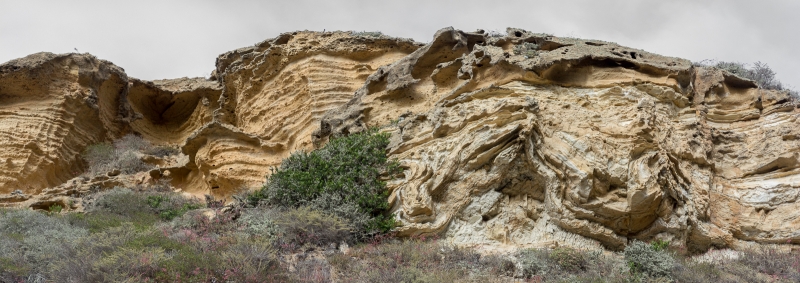
If “sea cow” brings to mind a manatee, you’re nearly there. Manatees are sea cows, as are their lesser-known cousins, the dugongs. Physically, a dugong differs from a manatee most notably in the tail, which is rounded like a ping pong paddle in manatees and bifurcated like a whale tail in dugongs. Dugongs also have different teeth and a different angle to their snout, and today they live in different parts of the world. Manatees are found around the warmer edges of the Atlantic Ocean (plus one freshwater species in the Amazon) and dugongs live along the fringes of the Indian Ocean and the Southwest Pacific. They get the name “sea cow” from their preferred diet of seagrass, which grows in the shallow coastal waters that serve as their pastures. Together they are the living examples of the order Sirenia, whose members are known as sirenians (a la sirens, or mermaids) because sea cow sightings by ancient seafarers were chalked up to mermaids. Looking at them today, we can only imagine how drunk those sailors must have been to get this rumor going. You might imagine that the sea cows have just really let themselves go in the intervening years, but they were no more attractive in their evolutionary past.
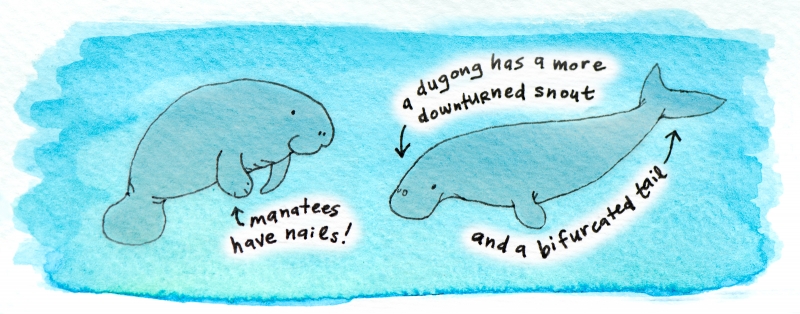
Some distinctions between manatees and dugongs (illustrated by the author)
As marine mammals, you might imagine them to be closely related to cetaceans (whales and dolphins) and pinnipeds (seals and sea lions) but they aren’t. Their closest living relatives are elephants, which makes them a distant cousin to the pygmy mammoths which later roamed Santa Rosa Island and now reside at the Museum. This isn’t so shocking when you consider that—like other marine mammals—the ancient sirenians once lived on land, and their fossil record has the legs to prove it. After an amphibious phase in the Eocene (an epoch spanning about 55 to 34 million years ago), their bodies became better adapted to a wholly water-bound lifestyle.
Among the adaptations that serve them well underwater are their massive and dense bones and skin, which help weigh them down as they graze on seagrass in shallow estuaries. Like those of land cows, the digestive systems of sea cows produce a lot of gas as they digest all that grass, and their heavy bones help counteract this so they don’t need to exert a lot of effort to stay down at the level of their food. One of the incidental effects of this high bone density is something that puts a smile on the faces of paleontologists: these bones, being made of sterner stuff than the rest, have a better chance of standing up to the tests of time and weather. As a result, the sirenian fossil record is rich, which has implications beyond understanding their history alone. Thanks to stable isotope analysis—a technique that relies on the fact that animals are what they eat—we know that ancient sirenians liked seagrass as much as their living descendants do, so it stands to reason that where we find their bones, seagrass once grew. This is a great boon to paleobotanists and paleoecologists, because the seagrass fossil record is about as pitiful as you’d expect for a plant that doesn’t leave behind any of the hard structures that fossilize well.
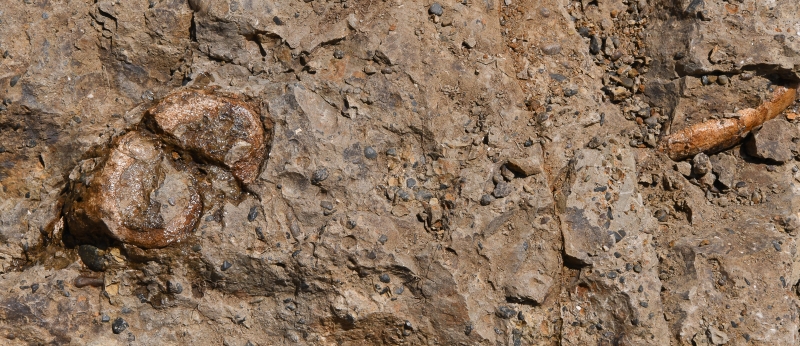
Big-boned: hefty sirenian centrum (part of a vertebra) and rib in situ. The dark, shiny appearance of the bones is due to consolidant (a special reversible glue used to stabilize fragile materials).
So we can suppose that 20-25 million years ago seagrass waved serenely in the gentle currents of a river’s mouth, where today bunchgrasses are bent low by the unforgiving winds blasting off the Pacific. At that time, Santa Rosa Island truly was a different world. In fact, it wasn’t Santa Rosa Island at all. For one thing, it wasn’t an island, and for another, it wasn’t here, having not yet rotated up into place from the San Diego area with the rest of the Transverse Ranges. So our dugong isn’t strictly a local, but we’re proud of it anyway. The specimen—discovered by field geologists with the United States Geological Survey—hit national media with a big splash last fall, because it’s the first sea cow to be discovered on our Channel Islands.

The sea no longer reaches us up here, but the marine layer does.
The Museum serves as the repository for paleontological materials from Channel Islands National Park, so the dugong’s destiny lay here. The park’s status as a remarkable paleontological resource was one of the reasons it was set aside for preservation in the first place, so having an official repository for those materials is crucial, and SBMNH is proud to serve in this capacity. These specimens have profound educational and scientific value, and they belong in the hands of scientists who can learn the most from them, and museums that can share them with the public. This is why it’s illegal to disturb or collect fossils or any other objects in the park without a permit, and why the paleontological work conducted in the park by scientists (including our own) must all be specially authorized under scientific research and collecting permits. If you see something significant on a visit to the park, you can protect these important resources by leaving them in place and notifying a park ranger.
SBMNH hadn’t led a paleontological expedition in more than four decades, since the heyday of Curator of Paleontology and Anthropology Phil C. Orr. This is mainly because we’ve long been without a paleontologist on staff, though we have had at least one as an excellent volunteer. Fortuitously, when the dugong was discovered, the Museum had just hired Dr. Jonathan Hoffman as our Dibblee Collection Manager of Earth Science. (Hoffman’s position is endowed by the Dibblee Foundation, which preserves the legacy of the prolific California geologist and cartographer Thomas Dibblee. Look for the latter’s beautifully color-coded maps of the state in our online store.)
Hoffman arrived on the scene not a moment too soon, leading an expedition to the site in November 2017. The sea cow had waited millions of years, but once it was exposed to the elements, time was of the essence. The original specimen spotted by USGS scientists had already broken off and rolled some distance away. Some large fragments were recovered, but the focus turned to a second specimen in a more accessible part of the site. The erosive forces of wind and water that had revealed this second sea cow would also be its undoing if the fossil wasn’t stabilized.
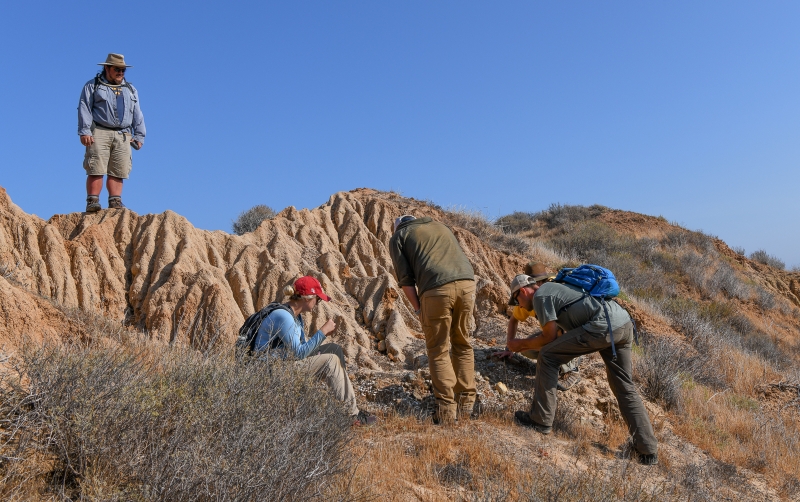
The dig crew inspects a great example of the wicked erosion typical on the island, at Johnsons Lee on the south side
You might not think of a fossil as fragile, but it can be. To understand why, here’s a refresher on how fossils are made. Something—something lucky, depending on your perspective on fame after death—dies, and is quickly covered up, usually by mud or sand. Preferably there is little oxygen under there with it. In the presence of oxygen, bacteria would cause the remains to decay quickly, but without much oxygen, the process of decay is slowed as the surrounding sediments become more and more firm around the hard structures that remain, like bones and teeth. Water and minerals seep in very slowly, filling in any openings in the material (like the pore spaces in bones) bit by bit, while maintaining the structure. Eventually you have a handy-dandy stone copy of the bones.
But not all stone is equally unyielding, as the erosion-scarred canyons of Santa Rosa Island demonstrate. The wind that comes directly off the Pacific is an ongoing scourge for its bent-over plants and weathered stones. On top of that, heavy winter rains were forecast for the winter of 2017-2018, though at that time we had no idea how much they’d impact us here in Santa Barbara. There wasn’t time to excavate the fossils, but they could be stabilized with specialized glue and given some weatherproofing in the form of a plaster jacket. Hoffman worked with a crew of experienced volunteers to trench a perimeter around the exposed remains and stabilize them with consolidant and layers of toilet paper, medical bandages, and plaster-infused burlap.
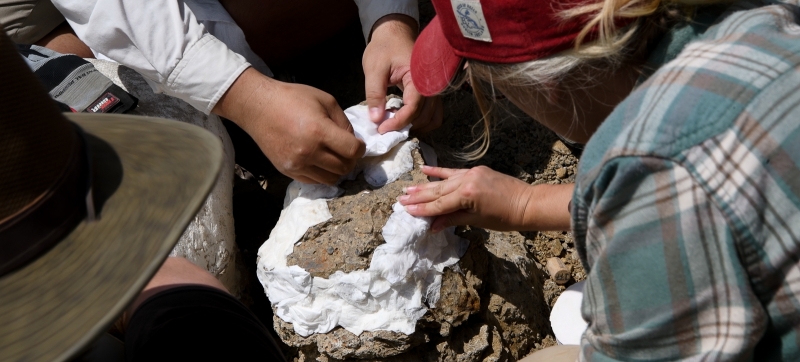
A base layer of wet TP protects the specimen from sticky plaster. Also worth noting: when you work this closely with your colleagues, you better like ‘em. Especially when rock hammers are involved.
Did the mention of toilet paper raise your eyebrows? The inner layer of double-ply (only the finest for fossils) acts as a soft barrier between the specimen and sticky plaster, which might otherwise pull it apart when the jacket is opened. As winter closed in, the crew worked quickly to apply this protection, and carried out a massive block of sirenian ribs that had weathered out of a different rock layer, which they were permitted to remove before it was destroyed by erosion. Then they returned to the mainland and hoped for the best. They would not see any dugongs again for nine months.
That is, except for the recovered chunk, a 30-pound block of big-boned stone revealing promising traces of sea cow. SBMNH Volunteer Preparator Chris Everett (a master’s student studying paleobiology at UCSB’s Department of Earth Science) has invested a lot of elbow grease in this specimen. Everett was one of the original team on the stabilization expedition who lugged this chunk of dugong out of the steep-sided canyon site. Upon returning to SBMNH he clocked 38 hours preparing it, painstakingly removing extraneous bits of matrix, the material in which fossil bones are suspended.
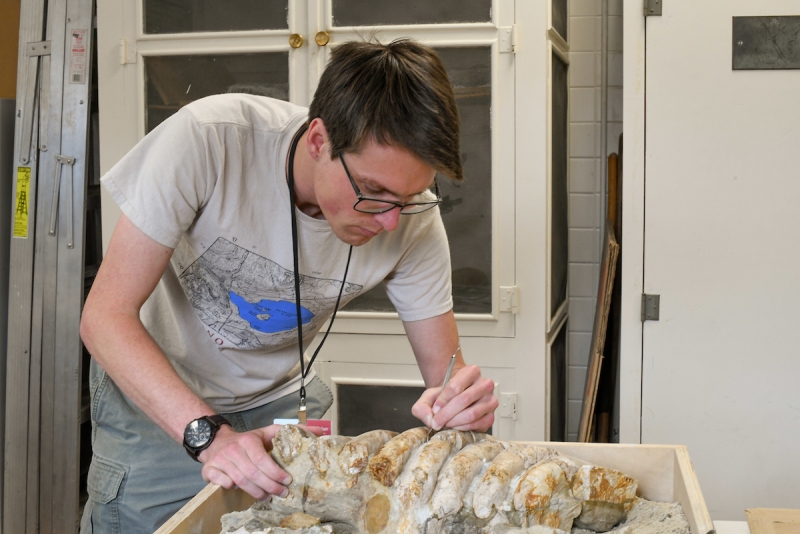
SBMNH Volunteer Preparator and UCSB Earth Science master’s student Chris Everett hard at work in May 2018, preparing the rib block for study and display
Everett shaved off about 10 pounds of weight and revealed an array of beautifully marbled orange-and-white ribs. Naturally, Everett was on the team when Hoffman organized an expedition to return to the site and excavate the stabilized specimen in August 2018.
The overall goal of the excavation expedition—as described by the permit—was to recover material associated with the main exposed specimen. This meant not only recovering the blocks isolated and jacketed during the stabilization expedition, but probing the sloping hillside above the largest jacketed specimen, a stretch of sandy soil and eroded rock underlaid by hard conglomerate. Hoffman suspected more fossilized bones were likely to be in this area because of the drifting pattern shown in what had been previously exposed and jacketed, but—lacking X-ray vision—didn’t know precisely where or how deep all of the hidden bones lay. The excavation started with gentle scooping of loose, eroded rock and soil on the surface. When sandy shale and then hard conglomerate was exposed, it was cautiously chipped at, then finally explored with the tentative probing of dental picks. Every piece separated from the whole was scrutinized for what it might contain.
While this may sound tedious, fieldwork is a joy. After all, it’s the fantasy of being in the field and uncovering fossils at a site that brings most people into paleontology. But it’s also work, and having the right crew makes all the difference when it comes to balancing work with joy. The members of the volunteer crew spanned a wide range of age and experience, from University of Wyoming Professor Mark Clementz (Hoffman’s former Ph.D. advisor and a contributor to the scientific literature on sea cows) to Brooke Roselle, a driven undergraduate majoring in geosciences at Pennsylvania State University. As the primary investigator, Hoffman assigned duties, directing more experienced crew members to take on the more challenging and delicate tasks.
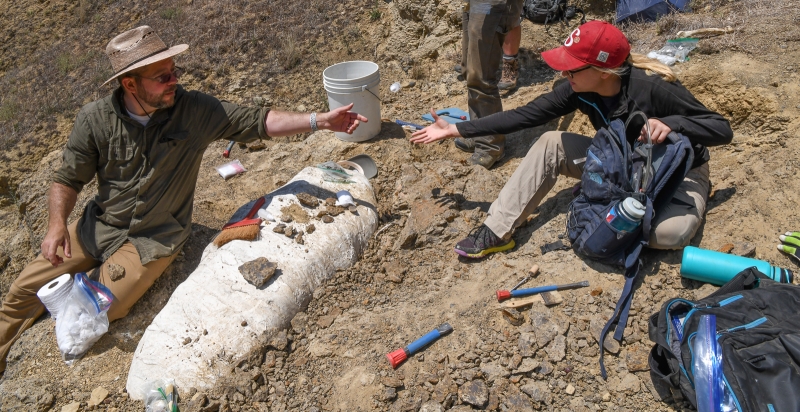
University of Wyoming Prof. Mark Clementz working across the main jacketed specimen with Penn State undergrad Brooke Roselle
Clementz’s extensive experience was put to good use in an area rich with fragile specimens of invertebrate fossils and casts. With sharp eyes and patient hands, he removed dozens of these casts (which preserve the shape of the original object without retaining any of the original material) of bivalve and gastropod shells, as well as fragments of crab claws and other specimens. Although a vertebrate specialist, Clementz was philosophical about carefully working through these delicate invertebrates. “In digging for fossils, it’s a slow process, but the nice thing about this site here is there are a lot of other fossils, a lot of invert[ebrate] fossils to keep you motivated.”
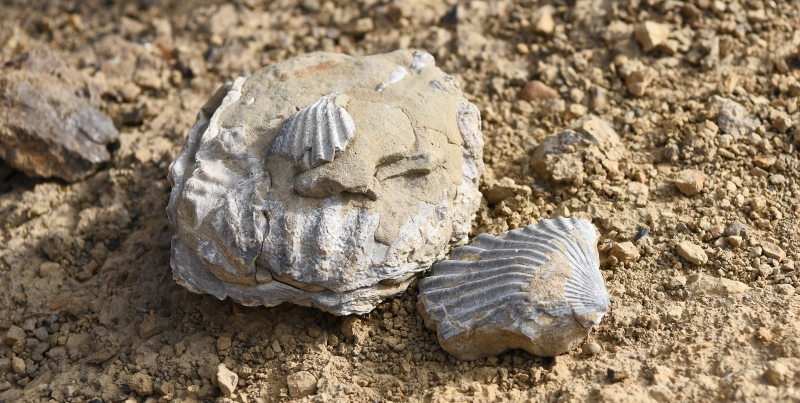
Beautiful bivalves from the surrounding strata may tell us more about where and when the ancient sea cow lived.
They could also hold the key to learning more about the ecology of the sea cow’s world. The casts provide a glimpse of the invertebrate community that shared the ancient seas with the sirenian, and may help narrow down the date of the assemblage. If some of the recovered shell and barnacle fragments contain the aragonite of which they were originally formed, radioactive isotope analysis could help date the fossils more precisely.
At the other end of the main jacketed specimen, Peter Kloess—a UC Berkeley Ph.D. candidate and veteran of dinosaur digs from Montana to Mongolia—took on the extremely fiddly job of removing material from between the main jacket and the section of the hillside just above it. This was challenging because important fossils—exposed ribs and vertebrae—lay in this hillside section, but would have to be isolated and removed separately from the main jacket, to keep the pieces manageable for transport and preparation. Kloess worked along the tight, shallow space along the edge of the jacket, deepening it sufficiently to begin undercutting the adjacent pedestal of hard rock in the hillside. Throughout this work, Kloess was careful not to lean his body—or even his chisel-holding hand—against the fossil-rich areas to either side, which would risk transmitting damaging vibrations when he struck the chisel with his hammer. This high-stakes game of Operation became increasingly difficult as the crevice grew deeper with his toil.
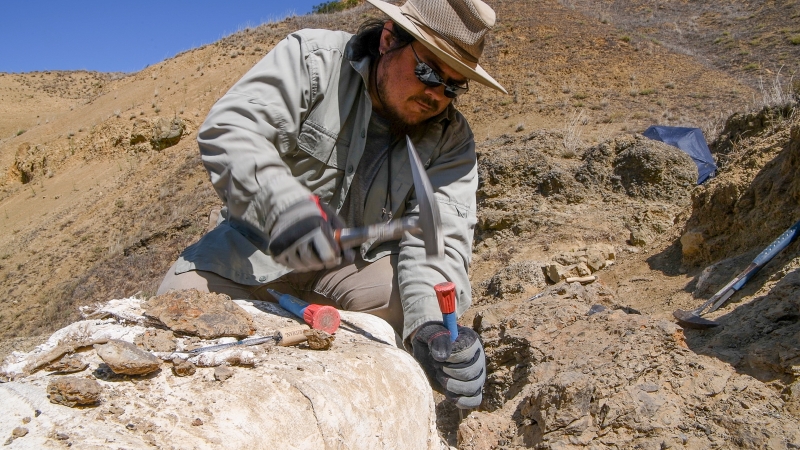
Kloess cautiously carves a perimeter between the jacketed specimen and a pedestal chock full o’ bones
Happily, at the end of each day, Kloess had the consolation of returning to an apartment with running water and electricity. With the support of CINP, our crew enjoyed the comforts of civilization whenever they weren’t at the site. Kloess emphasized how refreshing this was as he checked his email via wifi while relaxing exhausted muscles in a reclining chair. “You should know,” he confided, “this is not typical for fieldwork.”
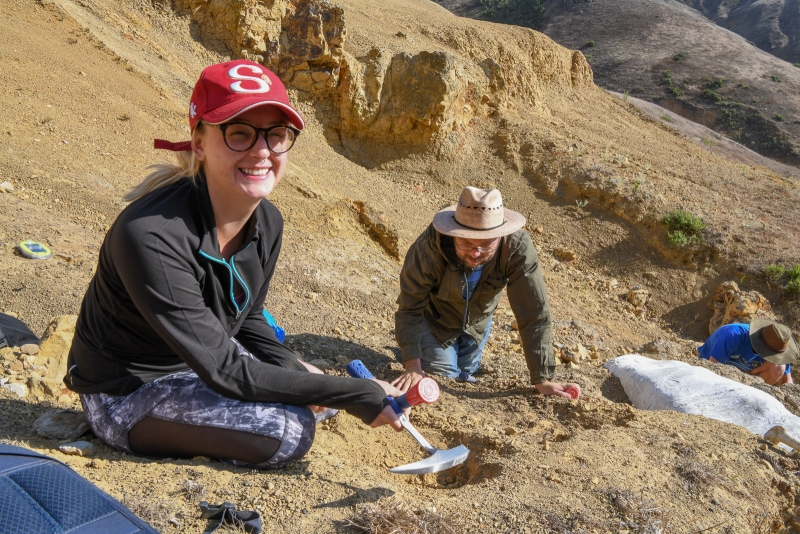
Pumped to be doing fieldwork: dig team volunteer and Pennsylvania State University undergrad Brooke Roselle
Working between Clementz and Kloess was Brooke Roselle, the youngest member of the field crew. Roselle has been searching for fossils since early childhood, but as an undergraduate, fieldwork is still a pretty novel experience for her. Despite being challenged by the hot Southern California sun, she stayed positive as she carefully cleared away matrix from the emerging pedestal on the hillside. “It’s pretty cool,” she said. “Slowly working down into it, it’s just really rewarding to finally get as close as we can.”
In learning from the full experience, Roselle wasted no time in asking questions of the more experienced volunteers, including “So have you ever accidentally broken anything in the field?” This was followed by laughter all around. “Anyone who says they haven’t is lying,” Hoffman opined. “Or they’re lying about having done fieldwork.” Scientists are people, too, and people make mistakes. But as humans, we have the capacity to learn from our mistakes. (This capacity is also what makes science work.) Developing skill in this area—as in any other—is based on calculating risk based on your current knowledge. These calculations were particularly in evidence when Everett—supervised by Dr. Hoffman—took on the important task of undercutting the small jacket containing fragments of the sea cow’s skull.
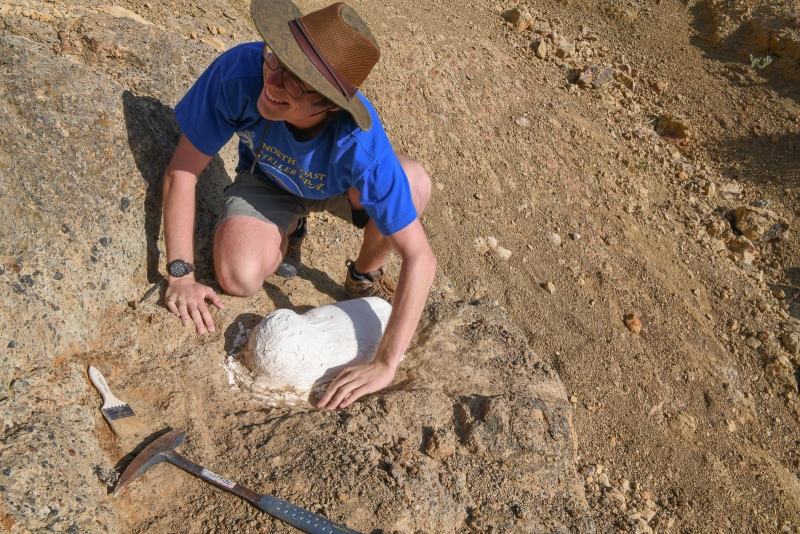
Everett beginning to trench around the skull jacket
Skulls have great scientific value because they typically display a lot of features that can be used to identify a species. Hoffman hopes that the skull fragments of this sea cow—once prepared—can be analyzed by his collaborating colleagues (particularly sirenian expert Dr. Jorge Velez-Juarbe of the Natural History Museum of Los Angeles County) to determine whether this specimen represents a previously described species or one unknown to science. During the stabilization expedition in November 2017, Hoffman and his team cautiously isolated a wide margin of stone around the exposed top of the skull and applied a protective jacket. In August 2018, it was time to undercut that jacket enough to crack the isolated specimen away from the rock below it. This meant Hoffman and Everett had to estimate the location of fossils they couldn’t see, and work with great care to trench deeply enough around the giant white peanut shape of the jacket to make a clean break without exposing any unforeseen fossil material.
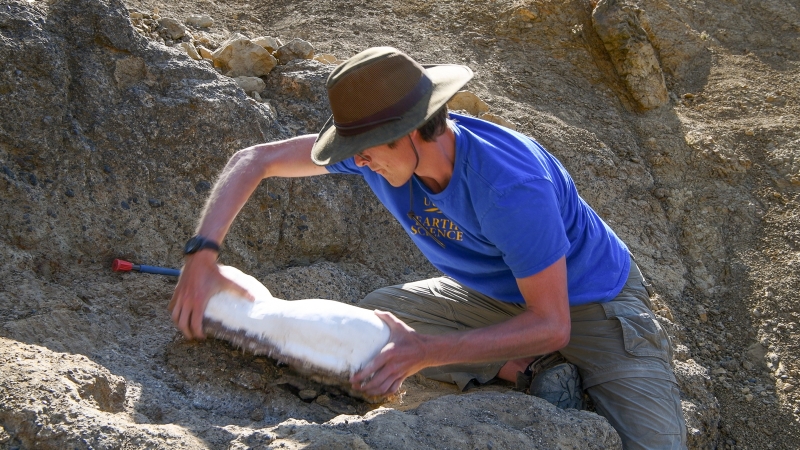
A tense moment as Everett flipped the skull jacket
When Hoffman judged that Everett had trenched deeply enough, they chiseled beneath the jacketed specimen to separate it from the underlying rock. As Everett prepared to flip the mostly-detached piece, the rest of the team put down their tools to watch, hoping that when Everett revealed the bottom, no new bones would be exposed. After getting a good grip, Everett flipped the peanut-shaped block, and smiled in relief to see only a small pile of fossil-less rock left behind. This meant they had likely judged correctly in supposing where the skull fragments were clustered. “Is this the only time paleontologists are happy not to see fossils?” I asked. “Pretty much,” Hoffman and Everett agreed.
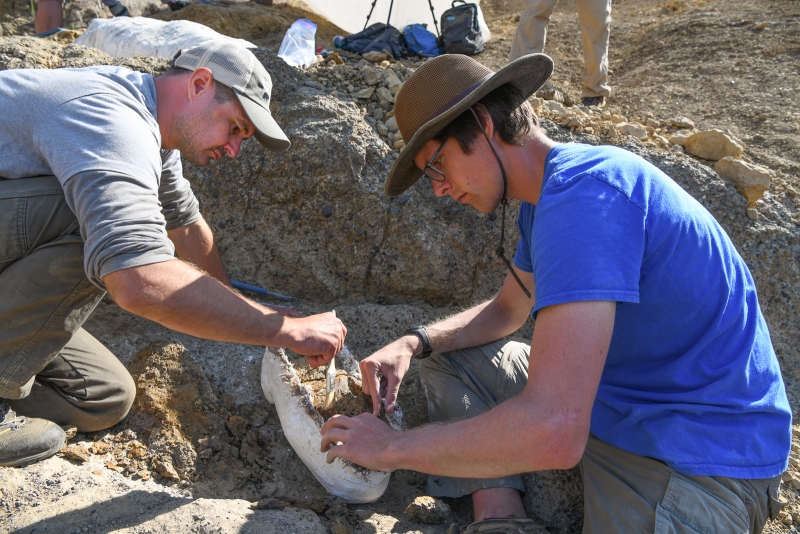
Dr. Hoffman and Everett preparing the flipped skull for further jacketing
The following week, a new crew swapped in to assist Hoffman. Their job was just as difficult, because before removing the jacketed segments, they had to dig further into a harder, deeper layer. The wind picked up that week, cooling them off a little but also covering them with the dust of the matrix they were busy pulverizing. “I looked in the mirror when I got back,” says Hoffman, “and I looked like a reverse raccoon with a white band around my eyes. The only part of my face that wasn’t coated in dirt was under my sunglasses.”
The effort to undercut the segments containing the dugong fossils was particularly hard because the layer beneath them was full of calcite, dissolved from the shells of invertebrates. The calcite—like cement—acted as a binder, tightly holding together the conglomerate. The week two team repeated the procedure that Everett had performed on the skull segment, but at a grander scale. After chipping through enough of the cement-like layer to create a fracture that went around the base of the large segments, they carefully wedged chisels under these segments and flipped them onto their protectively jacketed tops. This allowed them to jacket the bottoms, so that these massive segments—the largest weighing as much as 450 pounds—could be entirely swaddled in protective padding for transport.
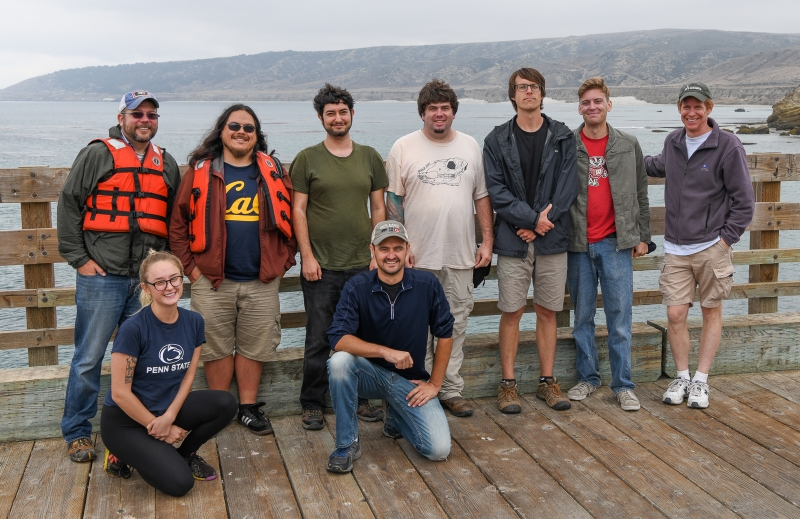
Changing of the guard: the week one and week two crews briefly united at the pier on Becher’s Bay. Standing, left to right: Dr. Mark Clementz, Peter Kloess, Anthony Caruso, Doug Shore, Chris Everett, Andrew McGrath, and John Sifling. Kneeling, left to right: Brooke Roselle, Dr. Jonathan Hoffman
While the paleontologists toiled at their hard labor, I took photos. These pictures—specimen and site photos that could supplement Hoffman’s field notes—could be a useful aid to researchers trying to understand the burial conditions. Unlike the photos I usually take around the Museum and Sea Center, they were calculated not to excite, but to inform, though I can testify that they excited at least one scientist: “Orr never had this,” Hoffman bragged to a colleague as he brandished an external hard drive full of photos back in the SBMNH Collections & Research Center.
When I wasn’t taking photos, Hoffman let me brush, probe, and chip away where I could do no harm, letting me get a feel for the demanding work. This—taken along with living in close proximity to the first week’s crew—taught me a thing or two about paleontologists. Granted, I only have five data points to extrapolate from (Hoffman, Clementz, Kloess, Everett and Roselle), but I’d still like to share these preliminary results about what paleontologists seem to share in common.
Despite coming from a range of generations (some more notably influenced by the Jurassic Park film franchise than others), many paleontologists fostered childhood dreams of working in this field. Paleontology is one of those professions—unlike actuarial accounting or call center management—that get a grip on a person early. In this sense, some paleontologists are still kids at heart, and as a consequence may more easily communicate with (usually dinosaur-obsessed) children than their peers in science who struggle with adjusting their language to a younger audience. The fact that they’re pursuing their childhood fantasy may also be accompanied by a paradoxically mature and self-deprecating awareness of the childish glee they’ve retained in their lifelong fixation.
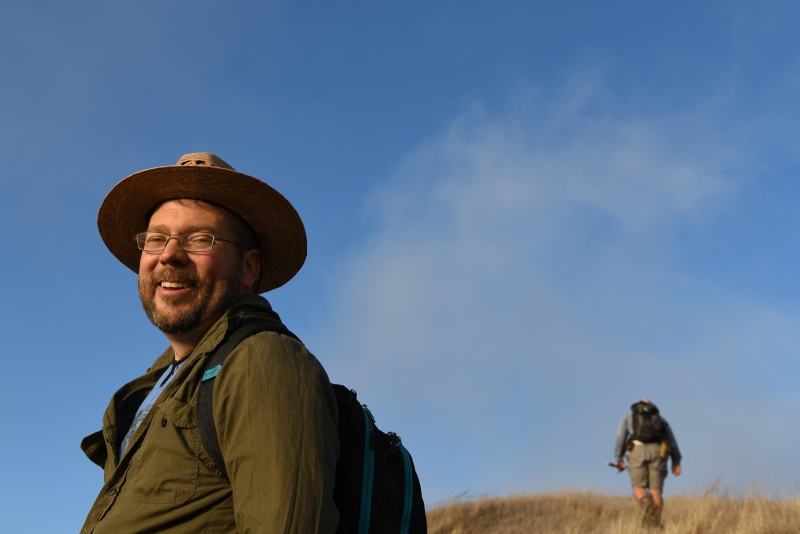
Clementz catching a well-deserved breeze at the top of the canyon
However, children are rarely known for their patience, which paleontologists have in spades. The fact that they’re still doing something they dreamed about as kids speaks to a deeply adult persistence shared by few modern humans. As in other academic fields, the training involved swallows up the so-called best years of one’s life, as doctoral students devote this time to study and research, often to the exclusion of pursuing hobbies or starting families. What’s the point of this sacrifice? Not just to engage in the search for fossils, but to do it right. People pursuing a formal study of paleontology learn not just how to identify the traces of ancient life, but how to do so in a way that makes a contribution to scientific knowledge. They learn to work transparently and methodically as part of teams: teams at dig sites, groups of colleagues at institutions collaborating on research projects, and the greater family of scientists throughout the world building our shared understanding of earth’s history. They document their work to maximize the potential for everyone to learn from it, and to do this they must collaborate with government agencies and private landowners to obtain their specimens legally.
This—more than the ability to distinguish between the ischium of a Velociraptor mongoliensis and the ulna of a Tyrannosaurus rex—is what separates real paleontologists from casual fossil hunters. While some fossil enthusiasts practice their hobby responsibly—taking photos and alerting authorities to the presence of fossil material so it can be studied in situ—too many (wittingly or not) rob the public and science of the opportunity to learn from specimens by illegally collecting. As Hoffman explains, “specimens lose scientific value when removed from their context. When paleontologists are out in the field collecting fossils, we record a lot of information about what’s around . . . When you remove a fossil, it’s like taking a body out of a crime scene.” Private collecting also denies future visitors to a site the chance to have the same experience. When fossils go into private collections, they often have survived for millions of years only to “end up forgotten in a shoebox in someone’s closet.” By contrast, legally permitted excavations result in the recovery of specimens that can contribute to our collective scientific knowledge and inspire a vast number of museum visitors.
On September 17, the ancient sea cow made a big step in a long journey toward becoming just such an inspirational display. The National Park Service crated the specimens and airlifted them from the site to the pier at Bechers Bay. The next day, the sirenian ventured out to sea again, riding an NPS boat back to the mainland, where it journeyed more prosaically along California Highway 101 and was safely deposited at SBMNH’s Collections & Research Center.
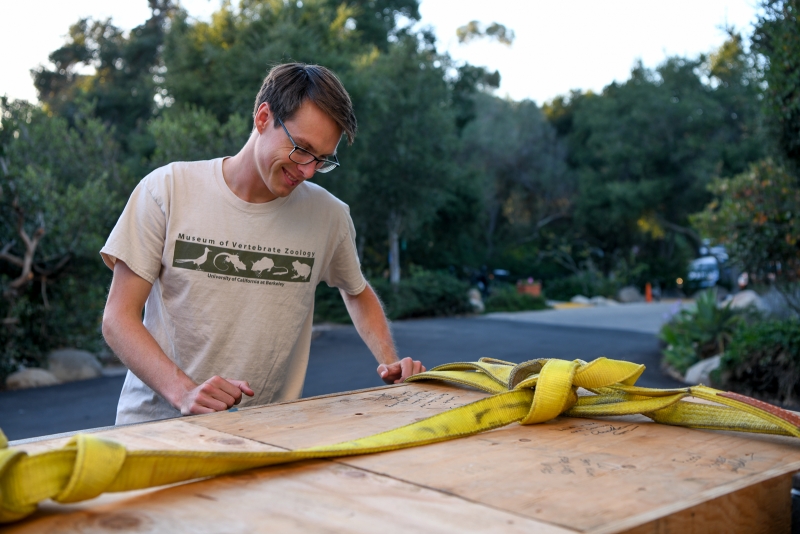
Christmas came early this year: Everett inspects congratulatory graffiti (written by week two volunteers and NPS personnel) on the specimen crate upon its arrival at SBMNH in mid-September
The specimens from the August 2018 excavation are already slated to be studied by researchers at seven different institutions, and are expected to result in contributions to scientific literature available to people all around the world. Chris Everett and Hoffman will continue the work of fossil preparation to isolate the sea cow and reveal as much as possible. If significant parts of the skull remain intact, Dr. Velez-Juarbe may be able to determine whether it belongs to a known species, or one yet to be described. If we’re very lucky and teeth remain in that skull—teeth not penetrated by the minerals that replaced the porous bone—it may be possible to use stable isotope analysis to learn much more about how this animal lived. But this work—like the careful, methodical work of the dig—will take time. Not 20-25 million years, but probably longer than the casual reader would expect.
In the meantime, many of the fossils in our collections from the Channel Islands are already on display in our exhibit halls, including some of the invertebrate fossils collected in fall 2017. For those who want to know more, Hoffman routinely takes interested guests behind the scenes to experience the range of fossils found on the islands. Because these traces of ancient life come from public lands, Hoffman emphasizes to his visitors that—while stewarded by SBMNH—they “belong to you and everybody else [in America].” We hope you’ll take up his invitation to visit and learn more about the history of our unique region; you don’t have to be a paleontology-obsessed eight-year-old, but it helps.
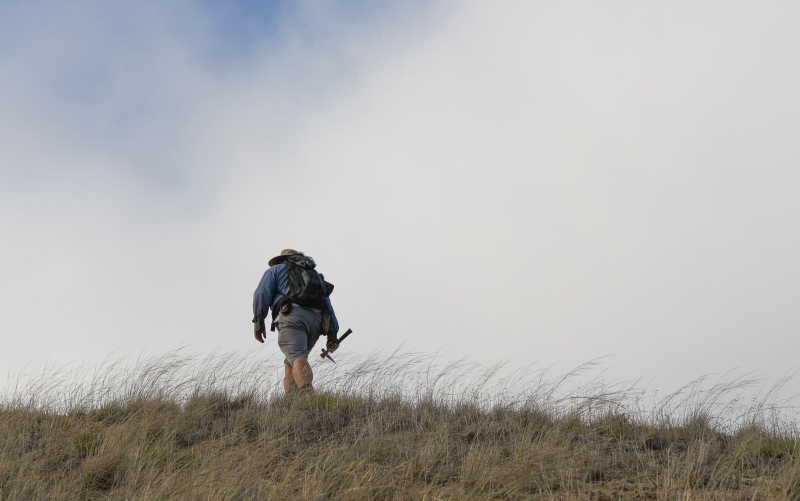
Kloess hikes off into the sunset
Keep up to date with any news about the sirenian of Santa Rosa Island at sbnature.org/seacow
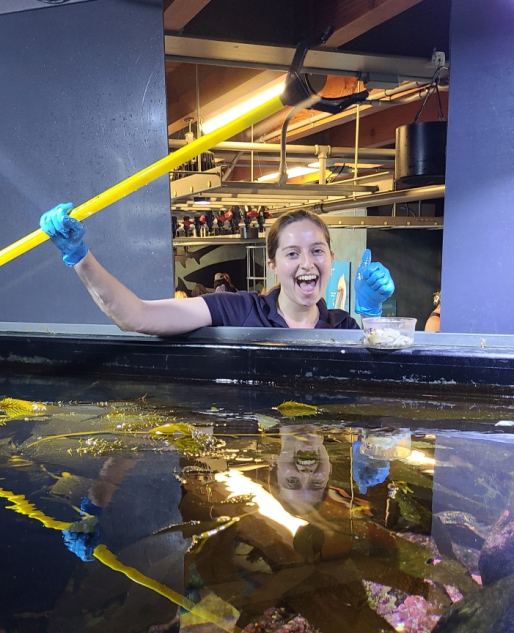
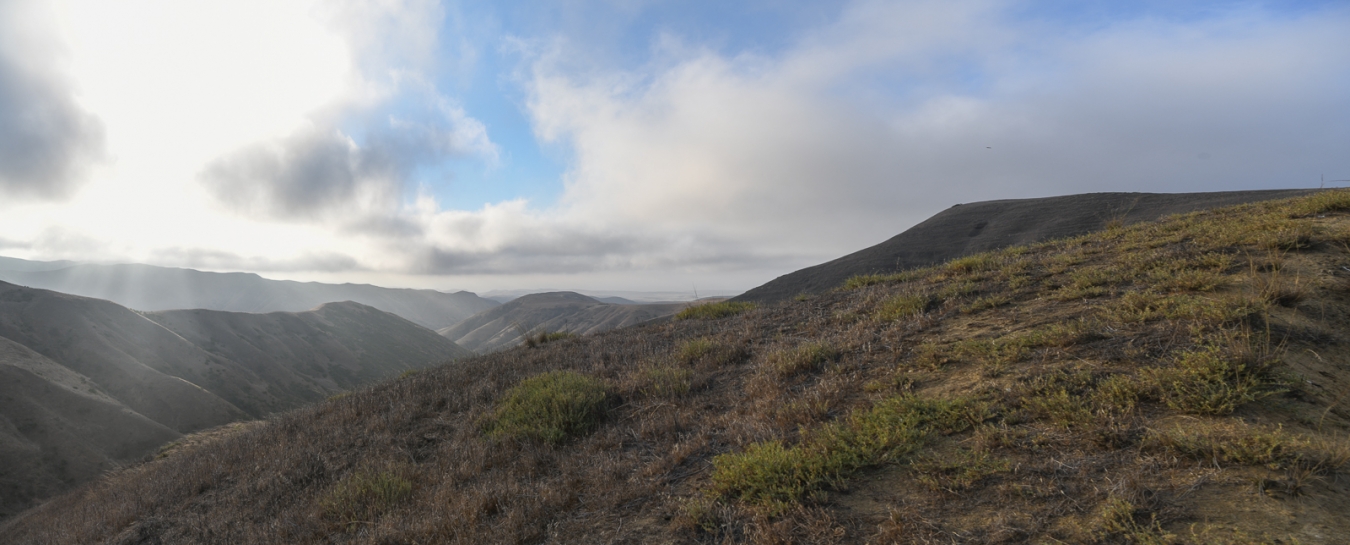
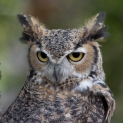
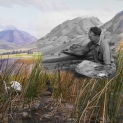
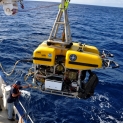


0 Comments
Post a Comment